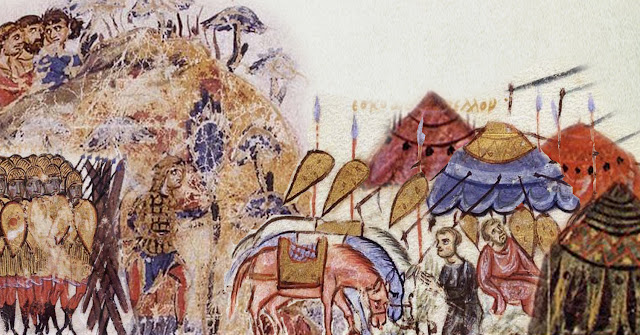In the autumn of 1078, a young general (and future emperor) of the Byzantine Empire by the name of Alexios Komnenos handed a freshly captured rebel leader named Nikephoros Bryennios the Elder over to an agent of Emperor Nikephoros III Botaneiates (r. 1078-1081). In exchange for the prisoner, the agent of the emperor delivered a message for Alexios containing a new task set to him by the crown. Around the same time that Bryennios’ rebellion was crushed, another rebellion had erupted in the city of Dyrrakhion (modern Durrës, Albania), led by Nikephoros Basilakios—Alexios’ task was to hunt down this third Nikephoros (whom we will simply refer to as Basilakios) and put a stop to the rebellion.
(Depiction of Emperor Nikephoros III Botaneiates (center) from the Bibliothèque nationale de France Manuscript Coislin 79 folio 2 verso, [Public Domain] via Creative Commons)
According to Alexios’ daughter and biographer, Anna Komnene, the rebel army of Basilakios marched from Dyrrakhion all the way to the city of Thessaloniki, which quickly fell under his occupation. In response, Alexios Komnenos moved his own forces along the Vardar River, which snakes down through Thessaly, west of Thessaloniki, and eventually merges with the Aegean Sea. Somewhere near Basilakios’ position, Alexios set up his camp on a plot of dry ground situated between two channels of the Vardar.
(Portrait of the Byzantine Emperor Alexios I Komnenos (r. 1081-1118), [Public Domain] via Creative Commons)
Sometime during the night, after an unknown period of time, Alexios watched with satisfaction from his hidden location as Nikephoros Basilakios and a force of reportedly 10,000 rebels charged straight into Alexios’ fake camp. Basiliakios allegedly leaped triumphantly into Alexios’ command tent, only to find it filled with servants and a monk. With Alexios nowhere in sight, Basilakios was said to have begun flipping tables and looking under desks and sofas, hoping to find the opposing general hidden under the furniture. The other rebel troops acted similarly—when they realized there were no enemy soldiers in the camp, they immediately lost all discipline and began to loot and pillage.
(Cavalry battle scene from the 13th century Madrid Version of the John Skylitzes Chronicle, [Public Domain] via Creative Commons)
The balance of the battle, however, had tilted heavily in Alexios’ favor. The dark of night, the rebel disorder and the aspect of surprise achieved by Alexios all combined to throw Basilakios’ rebels into chaos. The rebel force eventually lost the will to fight and fled from the Vardar River, giving Alexios an impressive victory for his resume.
Nikephoros Basilakios withdrew back to the safety of Thessaloniki, but an unrelenting Alexios was in hot pursuit. The city sheltered Basilakios, and refused Alexios entry, but when the general threatened to besiege the city, the citizens quickly opened the gates. Before Alexios could snatch his prey, Basilakios managed to lock himself inside the city’s citadel. Unfortunately for Basilakios, the citadel guards knew that they were on the losing side—they captured the rebel leader and handed him over to Alexios, who handed him over to the emperor, who had Basilakios’ blinded.
Written by C. Keith Hansley.
Top picture attribution: (Mashup of Madrid Skylitzes illustrations (medieval text about the Byzantine Empire), [Public Domain] via Creative Commons).
- The Alexiad by Anna Komnene, translated by E. R. A. Sewter. New York: Penguin Books, 2009.
- https://www.britannica.com/biography/Nicephorus-III-Botaneiates
- https://www.britannica.com/biography/Nicephorus-Bryennius-Byzantine-statesman-and-historian
- https://www.britannica.com/biography/Alexius-I-Comnenus
- http://www.forumancientcoins.com/catalog/roman-and-greek-coins.asp?vpar=2711




No comments:
Post a Comment